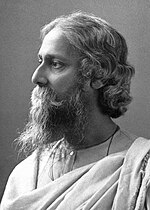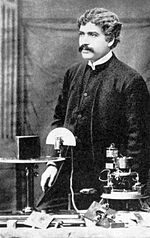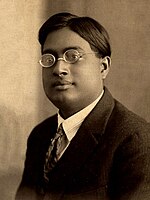Bengalis
   File:Bangabandhu02 big.jpg     File:Subhas Bose.jpg File:Subhas Bose.jpg1st: Atish Dipankar • Rabindranath Tagore • Kazi Nazrul Islam 2nd: Sheikh Mujibur Rahman • Ravi Shankar • F R Khan | |
| Total population | |
|---|---|
| ~250,000,000 (as of the year 2011) | |
| Regions with significant populations | |
| ~ Diaspora populations only of Bangladeshis | |
| 156,050,883[1] | |
| 70,000,000[2] | |
| 2,000,000[3] | |
| ~ 1,000,000 | |
| ~ 600,000[4] | |
| ~ 500,000[5] | |
| ~ 230,000[6] | |
| ~ 150,000[7] | |
| ~ 143,619[8] | |
| ~ 130,000[9] | |
| ~ 120,000 | |
| ~ 115,000[9] | |
| ~ 24,595[10] | |
| ~ 35,000[11] | |
| ~ 23,000[12] | |
| ~ 20,000[13] | |
| ~ 11,000[14] | |
| Languages | |
| Bengali and Bengali dialects | |
| Religion | |
Buddhism and Christianity – 1% [16][17] | |
| Related ethnic groups | |
| Bangladeshi diaspora, Aryan race, Mongoloid race, Assamese people | |
The Bengali people (Bengali: বাঙালি Bangali, Bengali: বাঙ্গালি জাতি Bangali jati) are an ethnic group native to the region of Bengal (now politically divided between Bangladesh and India), who are a hybrid race primarily evolved by mixture of the Aryan,Mongoloid and Proto-Australoid races.[19] They speak the Bengali language (বাংলা Bangla), which is an Eastern Indo-Aryan language, evolved from the Magadhi Prakrit language.
They are mostly concentrated in Bangladesh and the states of West Bengal and Tripura in India. There are also a number of Bengali communities scattered across North-East India, New Delhi, and the Indian states of Assam, Jharkhand, Bihar, Maharastra, Karnataka, Kerala, Andhra Pradesh, Madhya Pradesh, Uttar Pradesh and Orissa. In addition, there are significant Bengali communities beyond South Asia; some of the most well established Bengali communities are in the United Kingdom and United States. Large numbers of Bengalis have settled in Britain, mainly living in the East boroughs of London, numbering from around 300,000;[20] in the USA there are about 150,000 living across the country, mainly in New York.[21] There are also millions living across the Gulf States, majority of whom are living as foreign workers. There are also many Bengalis in Pakistan, Malaysia, South Korea, Canada, Japan, Australia, Singapore and many other countries.
History
Ancient history

Remnants of civilisation in the greater Bengal region date back 4,000 years,[22][23] when the region was settled by Dravidian, Tibeto-Burman and Austroasiatic peoples. The origin of the word Bangla ~ Bengal is unknown, though it is believed to be derived from the Dravidian-speaking tribe Bang that settled in the area around the year 1000 BCE.[24]
After the arrival of Indo-Aryans, the kingdoms of Anga, Vanga and Magadha were formed in and around Bengal and were first described in the Atharvaveda around 1000 BCE. From the 6th century BCE, Magadha expanded to include most of the Bihar and Bengal regions. It was one of the four main kingdoms of India at the time of Buddha and was one of the sixteen Mahajanapadas. Under the Maurya Empire founded by Chandragupta Maurya, Magadha extended over nearly all of South Asia, including parts of Persia and Afghanistan, reaching its greatest extent under the Buddhist emperor Ashoka the Great in the 3rd century BCE. One of the earliest foreign references to Bengal is the mention of a land ruled by the king Xandrammes named Gangaridai by the Greeks around 100 BCE. The word is speculated to have come from Gangahrd (Land with the Ganges in its heart) in reference to an area in Bengal.[25] Later from the 3rd to the 6th centuries CE, the kingdom of Magadha served as the seat of the Gupta Empire.
Middle Ages
One of the first recorded independent king of Bengal was Shashanka, reigning around the early 7th century.[26] After a period of anarchy, Gopala came to power in 750 by democratic election.[27] He founded the Bengali Buddhist Pala Empire which ruled the region for four hundred years, and expanded across much of Southern Asia, from Assam in the northeast, to Kabul in the west, to Andhra Pradesh in the south. Atisha was a renowned Bengali Buddhist teacher who was instrumental in revival of Buddhism in Tibet and also held the position of Abbot at the Vikramshila university. Tilopa was also from Bengal region.
The Pala dynasty was later followed by a shorter reign of the Hindu Sena Empire. Islam was introduced to Bengal in the twelfth century by Sufi missionaries. Subsequent Muslim conquests helped spread Islam throughout the region.[28] Bakhtiar Khilji, an Afghan general of the Slave dynasty of Delhi Sultanate, defeated Lakshman Sen of the Sena dynasty and conquered large parts of Bengal. Consequently, the region was ruled by dynasties of sultans and feudal lords under the Delhi Sultanate for the next few hundred years. Islam was introduced to the Sylhet region by the Muslim saint Shah Jalal in the early 14th century. In the early 17th century, Mughal general Islam Khan conquered Bengal. However, administration by governors appointed by the court of the Mughal Empire gave way to semi-independence of the area under the Nawabs of Murshidabad, who nominally respected the sovereignty of the Mughals in Delhi. After the weakening of the Mughal Empire with the death of Emperor Aurangzeb in 1707, Bengal was ruled independently by the Nawabs until 1757, when the region was annexed by the East India Company after the Battle of Plassey.
Bengal Renaissance
 |
 |
 |
 |
The Bengal Renaissance refers to a social reform movement during the nineteenth and early twentieth centuries in the region of Bengal in undivided India during the period of British rule. The Bengal renaissance can be said to have started with Raja Ram Mohan Roy (1775–1833) and ended with Rabindranath Tagore (1861–1941), although there have been many stalwarts thereafter embodying particular aspects of the unique intellectual and creative output.[34] Nineteenth century Bengal was a unique blend of religious and social reformers, scholars, literary giants, journalists, patriotic orators and scientists, all merging to form the image of a renaissance, and marked the transition from the 'medieval' to the 'modern'.[35]
Independence movement
- See also: Freedom fighters from Bengal
 |
Bengal played a major role in the Indian independence movement, in which revolutionary groups such as Anushilan Samiti and Jugantar were dominant. Bengalis also played a notable role in the Indian independence movement. Many of the early proponents of the freedom struggle, and subsequent leaders in movement were Bengalis such as Chittaranjan Das, Khwaja Salimullah, Surendranath Banerjea, Huseyn Shaheed Suhrawardy, Netaji Subhas Chandra Bose, Titumir (Sayyid Mir Nisar Ali), Prafulla Chaki, A. K. Fazlul Huq, Maulana Abdul Hamid Khan Bhashani, Bagha Jatin, Khudiram Bose, Surya Sen, Binoy-Badal-Dinesh, Sarojini Naidu, Aurobindo Ghosh, Rashbehari Bose and many more. Some of these leaders, such as Netaji, did not subscribe to the view that non-violent civil disobedience was the best way to achieve Indian Independence, and were instrumental in armed resistance against the British force. Netaji was the co-founder and leader of the Indian National Army (distinct from the army of British India) that challenged British forces in several parts of India. He was also the head of state of a parallel regime, the Arzi Hukumat-e-Azad Hind, that was recognized and supported by the Axis powers. Bengal was also the fostering ground for several prominent revolutionary organisations, the most notable of which was Anushilan Samiti. A large number of Bengalis were martyred in the freedom struggle and many were exiled in Cellular Jail, the much dreaded prison located in Andaman.
Partitions of Bengal
Bangladesh Liberation War
Religion
- Main articles: Demographics of Bangladesh, Demographics of West Bengal, Demographics of Tripura, and Demographics of Andaman and Nicobar Islands
 |
 |
Two major religions practiced in Bengal are Islam and Hinduism. In Bangladesh 88.3% of the population follow Islam (US State Department est. 2007) while 9.2% follow Hinduism. In West Bengal, Hindus are the majority with 71% of the population while Muslims comprise 27%. Other religious groups include Buddhists and Christians.[17]
Culture


Noted Bengali saints, authors, scientists, researchers, thinkers, music composers, painters and film-makers have played a significant role in the development of Bengali culture . The Bengal Renaissance of the 19th and early 20th centuries was brought about after the British introduced Western education and ideas. Among the various Indian cultures, the Bengalis were relatively quick to adapt to the British rule and actually used its principles (such as the judiciary and the legislature) in the subsequent political struggle for independence. The Bengal Renaissance contained the seeds of a nascent political Indian nationalism and was the precursor in many ways to modern Indian artistic and cultural expression.
The Bengali poet and novelist, Rabindranath Tagore, became the first Nobel laureate from Asia when he won the 1913 Nobel Prize in Literature. Other Bengali Nobel laureates include Amartya Sen (1999 Nobel Memorial Prize in Economic Sciences) and Muhammad Yunus (2006 Nobel Peace Prize). Other famous figures in Bengali literature include Ram Mohan Roy, Kazi Nazrul Islam, Arundhati Roy, Gayatri Chakravorty Spivak and Bengali science fiction writers such as Muhammed Zafar Iqbal, Humayun Ahmed, Jagadananda Roy and Roquia Sakhawat Hussain (Begum Rokeya). Famous Bengali musicians include Baba Alauddin Khan, Ali Akbar Khan, Ravi Shankar, Pankaj Mullick, R. C. Boral, Anil Biswas, Sachin Dev Burman, Rahul Dev Burman; Famous Bengali singers include Krishna Chandra Dey, Pankaj Mullick, Debabrata Biswas, Suchitra Mitra, Ritu Guha, Kanika Banerjee, Kishore Kumar, Abbas Uddin, Runa Laila, Hemanta Mukherjee, Manna Dey, Shyamal Mitra, Geeta Dutt, Sandhya Mukherjee, Nachiketa, Shreya Ghoshal, Shaan, Bappi Lahiri, Abhijeet, Kabir Suman and Rezwana Chowdhury Banya. Famous Bengali scientists include Sir Jagadish Chandra Bose, Meghnad Saha, Prafulla Chandra Roy, Prasanta Chandra Mahalanobis, Amal Kumar Raychaudhuri and Satyendra Nath Bose; famous Bengali engineers include Fazlur Khan and Amar Bose; famous Bengali filmmakers include Satyajit Ray, Nitin Bose, Bimal Roy, Mrinal Sen, Ritwik Ghatak, Tapan Sinha, Zahir Raihan, Aparna Sen, Rituporno Ghosh and Tareque Masud; and famous Bengali entrepreneurs include Sake Dean Mahomed, Amar Bose, Jawed Karim and Subrata Roy.
See also
- List of Bengalis
- List of Bangladeshis
- List of people from West Bengal
- Rohingya people
- Bangladeshi diaspora
Notes
- ^ "Population : Bangladesh: The World Factbook". Central Intelligence Agency. Retrieved 2010-09-08.
- ^ "Bengalis – Introduction, Location, Language, Folklore, Religion, Major holidays, Rites of passage, Relationships, Living conditions". Everyculture.com. Retrieved 2010-08-11.
- ^ The 2 Million Bengalis of Karachi - Daily Times
- ^ [1][dead link]
- ^ "Channel S, working for the community". Chsuk.tv. Retrieved 2010-08-11.
- ^ [2][dead link]
- ^ "Bangladeshis storm Kuwait embassy". BBC News. 2005-04-24. Retrieved 2010-04-26.
- ^ US Census 2000 foreign born population by country
- ^ a b Hasan, Rafiq (November 20, 2003). "4,000 Bangladeshis to return from Oman in December". The Daily Star. 4 (176). Retrieved 2008-12-19.
- ^ "2006 Census of Canada: Topic-based tabulations | Ethnic Origin (247), Single and Multiple Ethnic Origin Responses (3) and Sex (3) for the Population of Canada, Provinces, Territories, Census Metropolitan Areas and Census Agglomerations, 2006 Census – 20% Sample Data". 2.statcan.ca. 2010-05-19. Retrieved 2010-08-11.
- ^ UNB, Dhaka (2004-05-19). "The Daily Star Web Edition Vol. 4 Num 344". Thedailystar.net. Retrieved 2010-08-11.
- ^ "Ethnologue report for language code: ben". Ethnologue.com. Retrieved 2010-08-11.
- ^ "2006 Census QuickStats : Ingleburn (State Suburb)". Censusdata.abs.gov.au. Retrieved 2010-08-11.
- ^ [国籍別外国人登録者数の推移]
- ^ Comparing State Polities: A Framework for Analyzing 100 Governments By Michael J. III Sullivan, pg. 119
- ^ Bangladesh- CIA World Factbook
- ^ a b "Data on Religion". Census of India (2001). Office of the Registrar General & Census Commissioner, India. Retrieved 2006-08-26.
- ^ "Microsoft Word - Cover_Kapiszewski.doc" (PDF). Retrieved 2010-08-11.
- ^ In 1994, geneticist Luigi Luca Cavalli-Sforza of Stanford University divided a principal coordinant map of 42 Asian populations into three groupings: Asian Caucasoids, Northeast and East Asian and Southeast Asian. Along Southeast Asia, Cavalli-Sforza said there is a separation between northern and southern Mongoloids. To the West, Cavalli-Sforza said there is an approximate boundary between Caucasoids and Mongoloids from the Urals to the eastern part of India. Along this boundary there has been hybridization, causing a Caucasoid-Mongoloid gradient. Bengali people and Assamese people in the East India are one of in whom visible mongoloid features like salient cheek-bones and a different Epicanthal fold as noticeable with white-wheatish Aryan skin tone. Cavalli-Sforza, L.L., Menozzi, P. & Piazza, A. (1994). The History and Geography of Human Genes. New Jersey: Princeton University Press.
- ^ Ethnic Groups National Statistics Online (2001 census). April 2001. Retrieved on 2009-05-024.
- ^ Census Profile: New York City’s Bangladeshi American Population Asian American Federation of New York Census Information Center (2005). Retrieved on 2009-05-24.
- ^ "History of Bangladesh". Bangladesh Student Association @ TTU. Archived from the original on December 26, 2005. Retrieved 2006-10-26.
- ^ "4000-year old settlement unearthed in Bangladesh". Xinhua. 2006-March.
{{cite news}}: Check date values in:|date=(help) - ^ James Heitzman and Robert L. Worden, ed. (1989). "Early History, 1000 B.C.-A.D. 1202". Bangladesh: A country study. Library of Congress.
- ^ Chowdhury, AM. "Gangaridai". Banglapedia. Asiatic Society of Bangladesh. Retrieved 2006-09-08.
- ^ "Shashanka". Banglapedia. Asiatic Society of Bangladesh. Retrieved 2006-10-26.
- ^ A. Shiefner, History of Buddhism in India.
- ^ "Islam (in Bengal)". Banglapedia. Asiatic Society of Bangladesh. Retrieved 2006-10-26.
- ^
Georg, Feuerstein (2002). The Yoga Tradition. Motilal Banarsidass. p. 600. ISBN 3-935001-06-1.
{{cite book}}: Cite has empty unknown parameter:|coauthors=(help) - ^ Clarke, Peter Bernard (2006). New Religions in Global Perspective. Routledge. p. 209. ISBN 0-7007-1185-6.
- ^ A versatile genius, Frontline 21 (24), 2004.
- ^ Chatterjee, Santimay and Chatterjee, Enakshi, Satyendranath Bose, 2002 reprint, p. 5, National Book Trust, ISBN 81-237-0492-5
- ^ A. K. Sen (1997). "Sir J.C. Bose and radio science", Microwave Symposium Digest 2 (8-13), p. 557-560.
- ^ History of the Bengali-speaking People by Nitish Sengupta, p 211, UBS Publishers' Distributors Pvt. Ltd. ISBN 81-7476-355-4.
- ^ Calcutta and the Bengal Renaissance by Sumit Sarkar in Calcutta, the Living City edited by Sukanta Chaudhuri, Vol I, p 95.
